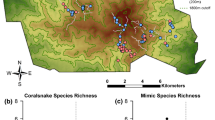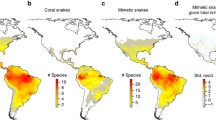Abstract
There are many examples of perfectly palatable animals resembling related unpalatable species and, thereby, avoiding attack by predators who have learnt or evolved to avoid the unpalatable species. To facilitate recognition by predators, unpalatable species often have warning colourations, which is what is mimicked by the palatable species. This form of mimicry is known as Batesian mimicry. While there are many well-documented examples of Batesian mimicry among butterflies and other arthropods, there are somewhat fewer examples amongst vertebrates, and even these examples are often debated. The coral snake mimicry system in North America, where non-venomous kingsnakes and milksnakes mimic venomous coral snakes, is one of the best-studied vertebrate examples of Batesian mimicry. However, it has also been debated for over a century. In this article, I will describe three experiments using plasticine replicas of the mimics designed to understand the effectiveness of their mimicry. These field experiments were performed in the natural habitats of the mimics, the models and their predators, by David W. Pfennig and his students and collaborators, in the states of Florida, North Carolina, South Carolina, and Arizona in the USA. The simple, clever, and low-cost experiments have significantly strengthened the hypothesis of Batesian mimicry in this system. They have also provided an unexpected new understanding of how mimics might evolve from cryptic ancestors through a process of gradual natural selection.
Similar content being viewed by others
Suggested Reading
G D Ruxton, W L Allen, T N Sherratt and M P Speed, Avoiding Attack: The Evolutionary Ecology of Crypsis, Aposematism, and Mimicry, (Second Edition), Oxford University Press, Oxford, UK. 2018.
R Gadagkar, Survival Strategies: Cooperation and Conflict in Animal Societies, Harvard University Press, Cambridge, Mass., USA, 1997 and Universities Press, Hyderabad, India, 1998.
R Deshmukh, S Baral, A Gandhimathi, M Kuwalekarand and K Kunte, Mimicry in butterflies: co-option and a bag of magnificent developmental genetic tricks, WIREs Dev Biol., Vol.7, p.e291, 2018. doi: https://doi.org/10.1002/wdev.291.
M Stevens, Cheats and Deceits: How animals and plants exploit and mislead, Oxford University Press, Oxford, UK, 2016.
J R Pannell and E E Farmer, Mimicry in plants, Current Biology, Vol.26, pp.R779–R793, 2016.
J A Roze, Coral Snakes of the Americas: Biology, Identification, and Venoms, Krieger Publishing Company, Malabar, Florida, USA, 1996.
V P Cyriac and U Kodandaramaiah, Conspicuous colours reduce predation rates in fossorial uropeltid snakes, Peer J, Vol.7, p.e7508, 2019. (DOI: https://doi.org/10.7717/peerj.7508).
V P Cyriac and U Kodandaramaiah, Don’t waste your time: predators avoid prey with conspicuous colors that signal long handling time, Evolutionary Ecology, Vol.33, pp.625–636, 2019.
H W Green and R W McDiarmid, Coral Snake Mimicry: Does It Occur?, Science, Vol.213, pp.1207–1217, 1981.
D W Pfennig, W R Harcombe, K S Pfennig, Frequency-dependent Batesian mimicry: Predators avoid look-alikes of venomous snakes only when the real thing is around, Nature, Vol.410, No.323, 2001.
G R Harper and D W Pfennig, Selection overrides gene flow to break down maladaptive mimicry, Nature, Vol.451, pp.1103–1106, 2008.
D W Pfennig and S P Mullen, Mimics without models: causes and consequences of allopatry in Batesian mimicry, Proceedings of the Royal Society B: Biological Sciences, Vol.277, pp.2577–2585, 2010.
G R Harper Jr. and D W Pfennig, Mimicry on the edge: why do mimics vary in resemblance to their model in different parts of their geographical range?, Proc. R. Soc. B, Vol.274, pp.1955–1961, 2007.
A Joshi, The Shifting Balance Theory of Evolution, Resonance, Vol.4, No.12, pp.66–75, 1999.
D W Kikuchi and D W Pfennig, High-model abundance may permit the gradual evolution of Batesian mimicry: an experimental test, Proc. R. Soc. B, Vol.277, pp.1041–1048, 2010. doi:https://doi.org/10.1098/rspb.2009.2000.
C K Akcali and D W Pfennig, Rapid evolution of mimicry following local model extinction, Biology Letters, Vol.10, 0304, 2014.
D Kikuchi and D W Pfennig, Imperfect Mimicry and the Limits of Natural selection, The Quarterly Review of Biology, Vol.88, pp.297–315, 2013.
A R Davis Rabosky, C L Cox, D L Rabosky, P O Title, I A Holmes, A Feldman and J A McGuire, Coral snakes predict the evolution of mimicry across New World snakes, Nature Communications, Vol.7, p.11484, 2016. DOI: https://doi.org/10.1038/ncomms11484.
D J McLean, G Cassis, D W Kikuchi, G Giribet, M E Herberstein, Insincere Flattery? Understanding the Evolution of Imperfect Deceptive Mimicry, The Quarterly Review of Biology, Vol.94, pp.395–415, 2019.
P W Bateman, P A Fleming and A K Wolfe, A different kind of ecological modelling: the use of clay model organisms to explore predator-prey interactions in vertebrates, Journal of Zoology, Vol.301, pp.251–262, 2017.
R Gadagkar, How to design experiments in animal behaviour — 12, Male frogs sing for sex but why don’t they do their best? Resonance: journal of science education, Vol.25, No.6, pp.817–838, 2020.
Acknowledgements
I thank Maria Modanu for drawing my attention to the experiments described in this article, David W Pfennig for discussion and for generously providing all the photographs reproduced here and David Kikuchi for answering many questions and supplying literature. I thank David Pfennig, Ullasa Kodandaramaiah, Maria Modanu and Sujata Deshpande for many helpful comments on the manuscript.
Author information
Authors and Affiliations
Corresponding author
Additional information
Raghavendra Gadagkar is DST Year of Science Chair Professor at the Centre for Ecological Sciences, Indian Institute of Science, Bangalore, Honorary Professor at JNCASR, and Non-Resident Permanent Fellow of the Wissenschaftskolleg (Institute for Advanced Study), Berlin. During the past 40 years he has established an active school of research in the area of animal behaviour, ecology and evolution. The origin and evolution of cooperation in animals, especially in social insects, such as ants, bees and wasps, is a major goal of his research. http://ces.iisc.ac.in/hpg/ragh. https://www.researchgate.net/proflle/Raghavendra_Gadagkar
Rights and permissions
About this article
Cite this article
Gadagkar, R. How to Design Experiments in Animal Behaviour. Reson 25, 1015–1044 (2020). https://doi.org/10.1007/s12045-020-1016-9
Published:
Issue Date:
DOI: https://doi.org/10.1007/s12045-020-1016-9




